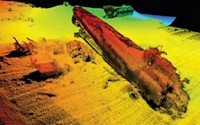Advertisement
Grab your lab coat. Let's get started
Welcome!
Welcome!
Create an account below to get 6 C&EN articles per month, receive newsletters and more - all free.
It seems this is your first time logging in online. Please enter the following information to continue.
As an ACS member you automatically get access to this site. All we need is few more details to create your reading experience.
Not you? Sign in with a different account.
Not you? Sign in with a different account.
ERROR 1
ERROR 1
ERROR 2
ERROR 2
ERROR 2
ERROR 2
ERROR 2
Password and Confirm password must match.
If you have an ACS member number, please enter it here so we can link this account to your membership. (optional)
ERROR 2
ACS values your privacy. By submitting your information, you are gaining access to C&EN and subscribing to our weekly newsletter. We use the information you provide to make your reading experience better, and we will never sell your data to third party members.
Environment
Mercury Down The Dental Drain
March 24, 2008
| A version of this story appeared in
Volume 86, Issue 12
A team led by Karl J. Rockne and James L. Drummond of the University of Illinois, Chicago, has investigated how much mercury and methylmercury, a bioaccumlative neurotoxin, is released from dentists' offices (Environ. Sci. Technol., DOI: 10.1021/es7027058). Mercury from dental waste accounts for 13–78% of Hg in publicly treated wastewater and primarily comes from amalgams used for fillings. Some dental clinics use traps to collect particulate waste, but in prior work the researchers found that dental drills grind the amalgam into very fine particles that may form stable suspensions in water, allowing mercury to escape the traps. In the new study, they let dental wastewater samples settle for 24 hours and then sampled the supernatant to estimate how much mercury would sidestep standard traps. They found a wide range of total mercury concentrations, from 0.02 to 5,000 μM, as well as methylmercury concentrations ranging from 2 to 270 nM. The researchers also tested for sulfate-reducing bacteria that are known to methylate mercury. They found a strong correlation between the bacteria and methylmercury levels, indicating that the bacteria may play a significant role in producing methylmercury in dentists' wastewater.






Join the conversation
Contact the reporter
Submit a Letter to the Editor for publication
Engage with us on Twitter